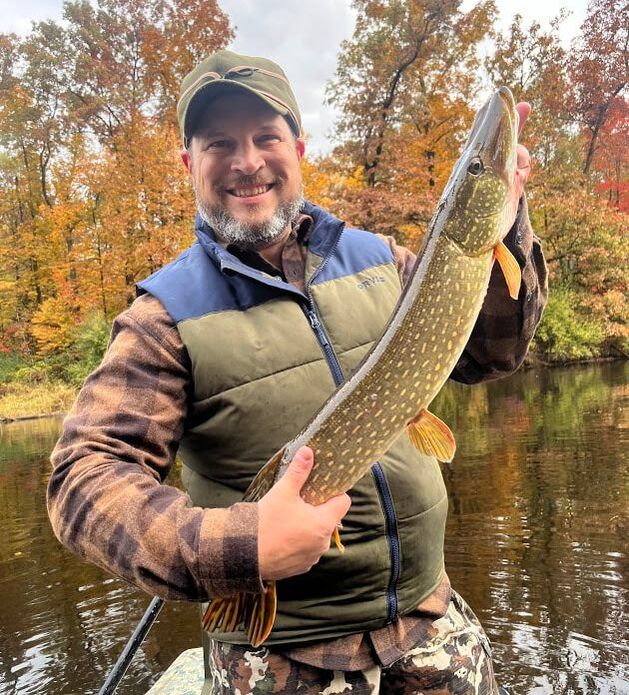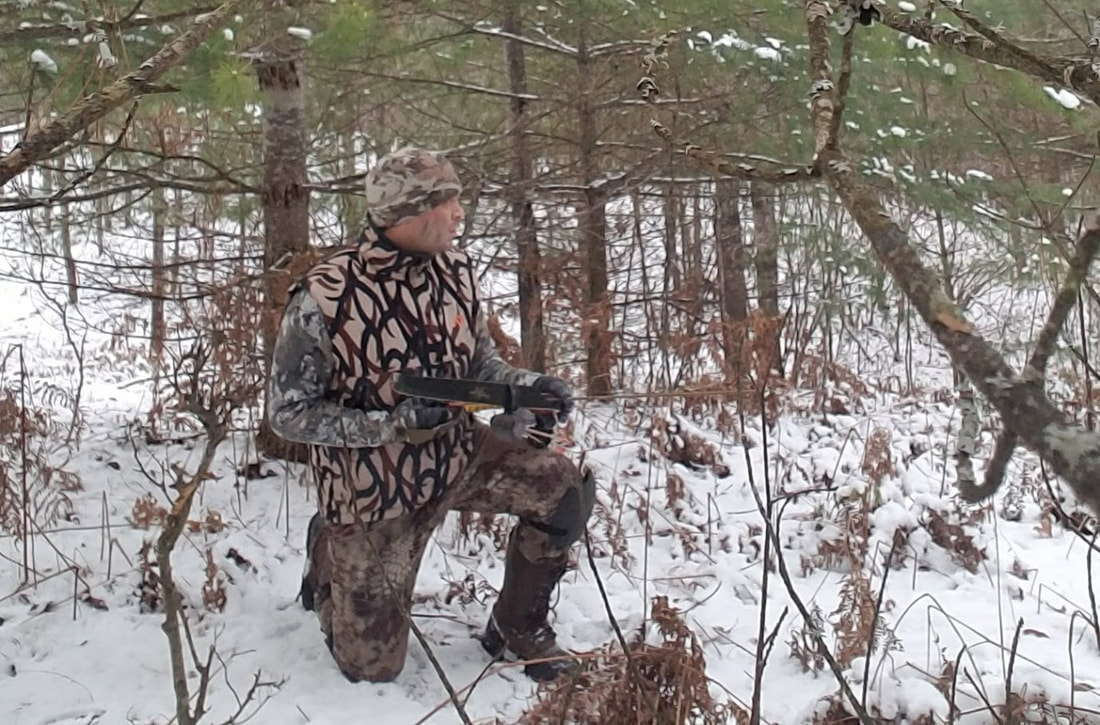|
By Drew YoungeDyke (Originally published in the October 2020 issue of Woods-N-Water News)
The topography looks just right. A slight knoll just inside the treeline at the edge of marsh, creating a natural funnel between the two. I kneel at the base of a tree on the opposite side of the knoll, about 35 yards away, so that just my head can see above it and I can rest against the tree. A short while later, a four-point walks through the funnel followed by a six-point. I carefully raise my bow, set the 35-yard pin on the six-point’s vitals, take a breath, and release an arrow. It sails underneath: too short. They both bolted. This is still hunting, I think. After that miss, while hunting public land on Beaver Island out of a backpack camp, I wondered if I’d ever find success still hunting deer. Was it madness to commit myself to a method with a lower chance of success? Why couldn’t I just do the tree stand/trailcam/food plot thing like seemingly everybody else? The answer was more complex than the success rate of the method, though. Still hunting is a simple concept that is hard to accomplish. It is hunting by moving slowly and silently through a landscape suspected to hold deer. In practice that means taking careful steps and stopping often – being still – while being observant for the slightest sign of deer, while paying close attention to wind, sound, your scent, and your surroundings. It can be done with any tool legal for deer hunting, increasing in difficulty in inverse relationship to the range of the firearm or bow. And it can take years to find success with each progression of difficulty. Or, luck can strike immediately. In truth, every encounter with deer while still-hunting feels a little lucky but it takes an almost perfect execution of the craft to kill a deer with the method. Rather than a deterrent, this is what hooked me on still hunting as my primary method for deer hunting. While some deer hunters find satisfaction in progressing maybe from smaller bucks to larger bucks, or from many deer to mature deer, I find it in seeking – and most often failing – the perfection of the woodcraft needed to successfully harvest any deer by still hunting. It’s also about the adventure of what might be in the field of view opened up by the next careful step. It could be a deer itself or funnel you’ve never seen with just the right cover at just the right distance that you have to sit for a few hours. It’s the freedom of being able to move to the next field of view at any time coupled with the discipline to stay and acquiring the experience of knowing when to do which. It’s the craft of moving silently – when I move at all – through a wooded landscape with the leaves changing in October or on a soft snow in November. It’s using the same method my dad taught me and my grandpa taught him. Most of all, though, it’s channeling the hunting instinct and feeling as purely human as I’ve experienced. On the Michigan archery opener after that miss on Beaver Island, I hunted along a deer trail in the Pigeon River Country. I often use deer trails as my travel routes when still-hunting because there is less vegetation to brush against and make noise. However, I do this only in wild public land, not where treelines on ag fields create funnels, for instance, where I might spook out mature bucks. In the country I hunt, deer trails are abundant and go in every direction. I determine the direction I want to take by the wind, the cover, and the contours of the land, and use the criss-crossing deer trails to piece together my route through the section I’m hunting. On that day, along that trail, I saw the movement of two does on a trail perpendicular to the one I was on. Ground vegetation was high so I dropped to a knee with my compound. I waited silently for the front doe to present a shot, drew when its head was down and facing away, and released the arrow. It ran twenty yards and dropped, its heart stopping while mine raced. I waited several minutes and then walked to it, discovering that it was a button buck, not a doe. Not my intention, but it would make good eating. I tagged it and carried it back to my backpack camp over my shoulder. Still hunting isn’t always moving; it often requires long periods of uncomfortable stillness without the comforts set up in a blind or a tree stand. The next year, I spent four days still hunting out of a backpack camp in the same part of the Pigeon River Country surrounded by bugling elk. By the last day, I had seen and blown stalks or otherwise spooked a dozen deer and missed one, the arrow deflected by vegetation I’d not noticed. Almost defeated, I glassed a valley from a ridge and saw a doe moving slowly though it. I crawled to the edge of the ridge and partway down it to set up behind some old timber slash. If the doe kept going the same direction, it would pass below me within bow range. Instead, it bedded down. I held my position laid back against the hillside behind the short slash pile, carefully raising my binoculars every now and then to look where it bedded. Well-hidden, I began do doubt myself, wondering if I missed it walking away at some point. Finally, it got up and walked right where I originally hoped it might. I drew my compound under the cover of the slash pile, but then the doe started walking up the trail toward me. I held my draw for about 45 seconds before I thought I might be able to get away with raising the bow without spooking the doe. I raised the bow, the doe looked toward me, and I released the arrow into front-quartering vitals at a distance of 35 yards. It dropped on the spot and I gutted it while two bull elk sparred less than a football field away. That was the last deer I’ve taken still-hunting with a bow; the next year I switched to a recurve and the 35-yard shots I might have taken with a compound have just been the starting point for a stalk with the recurve. Two years ago, I hunted along a ridge near an old logging two-track heading downhill with forest on my left and open upland on my right. I saw three does in the valley below and crawled downhill along the tracks to behind a small fallen log, each movement carefully planned while watching the does to avoid alerting them. I was still about 50 yards away, though, well beyond my 20-yard recurve range. Finally, I thought the coast was clear as trees blocked their view of me to leave the blowdown. I closed the distance maybe ten or fifteen yards when one of the does detected me, blew, and they all ran away while my heart pounded. In all my hunting experience, I don’t think I’ve ever been more infused with our natural human hunting instinct than on that stalk. As the September wind hints at the October to come, it stirs that instinct within me. And come October, there will come a moment when I engage it again, walking along a deer path, spotting some portion of a buck or doe, nocking an arrow to my recurve, and putting on a stalk. I don’t know if I’ll be successful or have another empty freezer, but I know I’ll be chasing perfection, on public land ground, in an intimate dance with a deer, without a tree stand in sight. I’ll be a still hunter once again. And in that perfect moment, that is all I will be. |
AUTHOR
Drew YoungeDyke is an award-winning freelance outdoor writer and a Director of Conservation Partnerships for the National Wildlife Federation, a board member of the Outdoor Writers Association of America, and a member of the Association of Great Lakes Outdoor Writers and the Michigan Outdoor Writers Association.
All posts at Michigan Outside are independent and do not necessarily reflect the views of NWF, Surfrider, OWAA, AGLOW, MOWA, the or any other entity. ARCHIVES
June 2022
SUBJECTS
All
|



 RSS Feed
RSS Feed